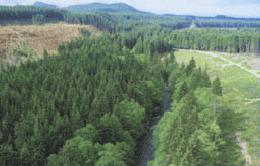On June 5, 2006, the U.S. Fish and Wildlife Service and the National Marine Fisheries Service approve Washington's Habitat Conservation Plan enacted by the State Legislature in 1999. Under the plan, private land owners were protected from enforcement of the Endangered Species Act for 50 years if they undertook certain steps during logging operations to protect salmon habitat. More than nine million acres of land, one fifth of the state, is covered in the plan.
Property owners who logged their land risked prosecution under federal law because the removal of the habitat used by salmon for spawning constituted a "taking" of an endangered species. The 1999 Habitat Conservation Plan, crafted by the forest products industry, state and federal agencies, and some Indian tribes required certain measures to protect salmon habitat such as restrictions on road building and leaving trees around streams. By complying with the requirements, landowners would not be prosecuted for the taking of salmon or of more than four dozen other endangered and threatened species for 50 years.
In 2003, Governor Gary Locke (b. 1950) requested that State Land Commissioner Doug Sutherland's Department of Natural Resources secure the non-prosecution assurances from the U.S. government. Sutherland's office finalized the agreement.
Under the plan, small-scale landowners -- those with lots of fewer than 20 acres -- had less stringent requirement than large-scale landowners. The planners believed that if the landowners were allowed to log they would be less inclined to sell the land for development, which was worse for salmon. Environmental groups and some tribal officials remained dubious about the benefits of the plan.
The final agreement was celebrated at a ceremony on June 5, 2006, attended by Governor Christine Gregoire, landowners, representatives of timber interests, tribes, and government agencies.

